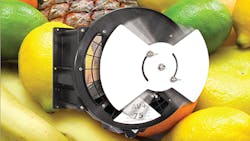Reefer container air exchange guide helps produce to breathe
The best advice from post-harvest biologists at the University of California is now available in an easy-to-use settings guide for air exchange technologies such as AV+.
This guide is the result of cooperation between refrigerated container producer Maersk Container Industry (MCI) and the University of California, aimed at achieving energy savings and delivery of fruit and produce in optimal conditions.
Using a carbon dioxide (CO2) sensor, AV+ allows the produce to dictate the level of fresh air exchange based on its respiration rather than an often ambiguous fixed-vent opening that is based on the presumption of a constant fan speed. However, fixed-vent openings leave many variables that can alter the actual air volume being exchanged.
The key is to provide the best possible conditions for fruit or vegetables in the cargo container from point A to B, said Malcolm Dodd, principal consultant, Cold Chain Solutions.
“The longest period of time during the post-harvest life of produce is usually spent inside a reefer container,” he said. “The fruit, flowers, or vegetables are still consuming oxygen and give off carbon dioxide. Open air exchange vents, known as AirEx, are not precisely engineered, and there is much variability in the amount of air that moves through the vents. There are also varied opinions around the globe regarding what is the best AirEx for different types of fresh produce. It makes sense to manage the air exchange with an engineering solution. The AirEx vent can be mechanized and the opening controlled according to the respiration rate of the product being carried. The result will be better quality produce after the shipping voyage.”
Key advantages of AV+ include:
• Reduced energy consumption—Minimal fresh air intake allows less warm air to enter the reefer. This in turn reduces energy consumption and allows faster pulldown.
• Less dehydration of produce—Excessive ambient air disturbs the desired humidity environment in the reefer, and increased cooling will lead to increased dehydration. This affects both the air and the produce.
• Provides the correct amount of fresh air, no more no less—Traditional CMH/CFM or % settings do not adjust for: 50/60-Hz power supply differences, software type/fan speed (Quest, DTMS, eco mode etc), packing patterns/materials, or respiration rate changes as cargo temperature reduces. AV+ will provide the needed fresh air regardless of these factors.
• Reduced ripening and improved quality—Some produce types benefit from increased CO2. This enables better “firmness”, reduced ripening, and better appearance.
• Reduction of external gases—Undesired gases, such as ethylene, can come from engine exhausts or gen-sets. Thus, trucks can cause risk to the cargo, but this risk is minimised with AV+.
To see the settings guide, click here. Click here to see a video on how AV+ works.
